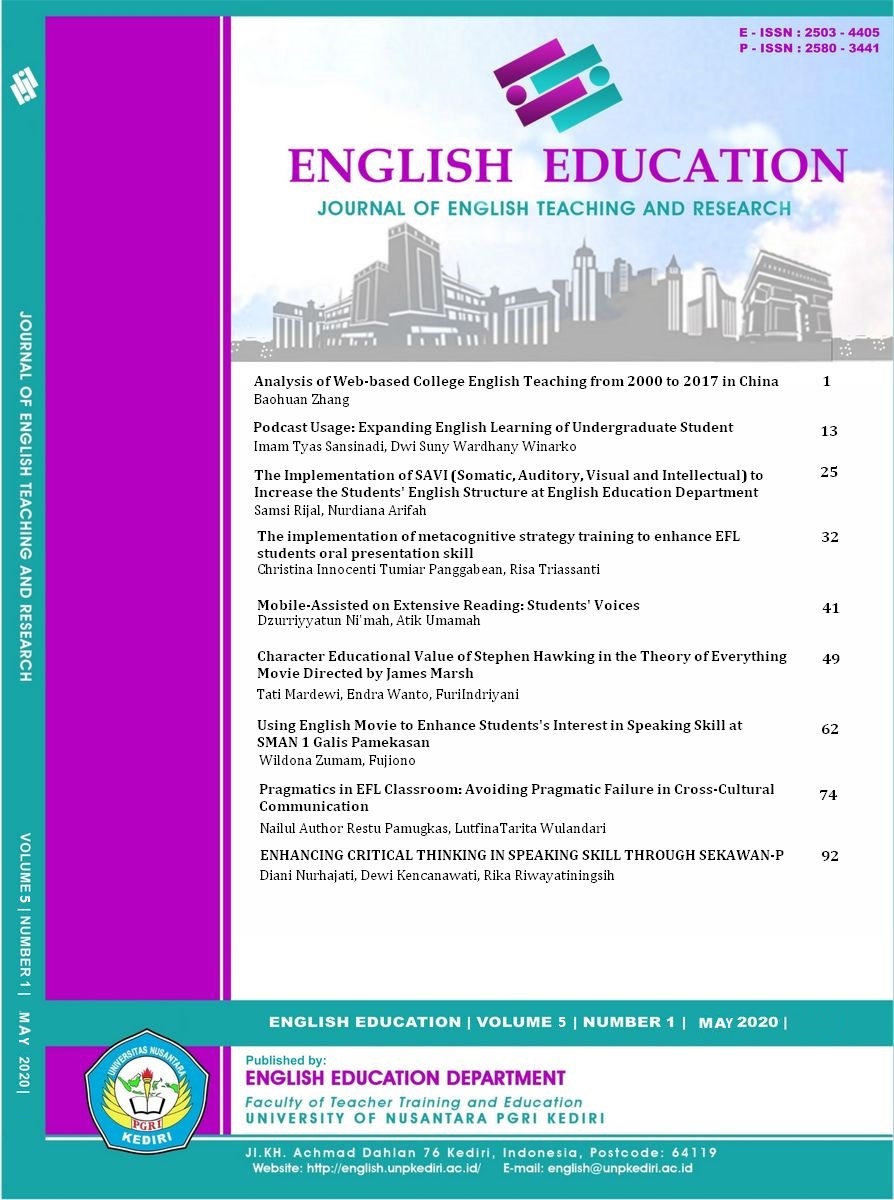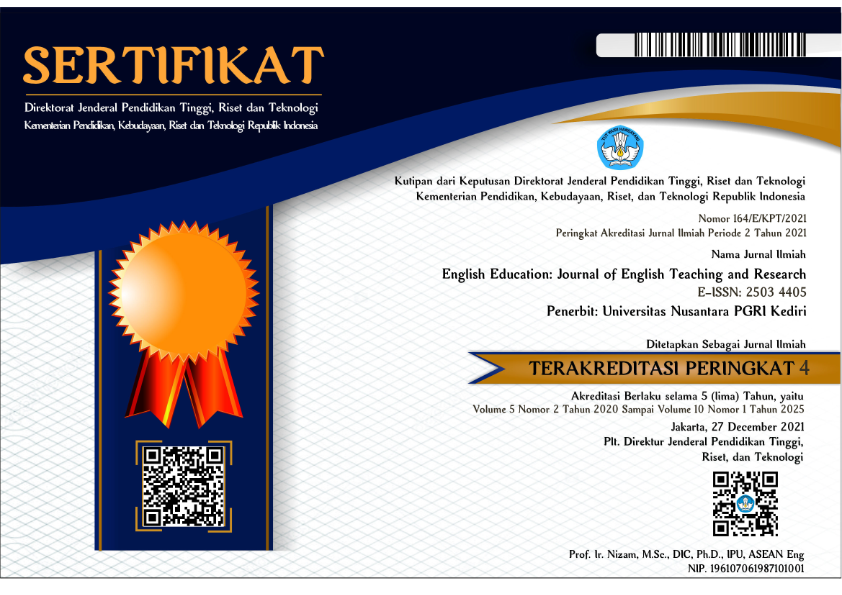THE IMPLEMENTATION OF SAVI (SOMATIC, AUDITORY, VISUAL AND INTELLECTUAL) TO INCREASE THE STUDENTS’ ENGLISH STRUCTURE SKILL AT ENGLISH EDUCATION DEPARTMENT
DOI:
https://doi.org/10.29407/jetar.v5i1.14236Keywords:
SAVI (SOMATIC, AUDITORY, VISUAL AND INTELLECTUAL), English Structure.Abstract
This research begun from the students’ problems in understanding the English structure at the first semester of English Education Department, Teacher Training and Education Faculty, Madura Islamic University (UIM) Pamekasan. From the data, it showed that most of students did not achieve the target score 75 (B), it was only 43.75% students. These problems occurred because 1) they used to memorize the pattern of English structure, 2) they seldom practice it in spoken or written, 3) they felt afraid of making mistakes. Concerning with these, the researcher tried to solve by implementing an appropriate strategy, it is SAVI (SOMATIC, AUDITORY, VISUAL AND INTELLECTUAL) which was introduced by Dave Meire. The research design is Classroom Action Research (CAR). It was done in two cycles with four steps; planning, acting, observing and reflecting. After conducting the research, there were significant improvements of students’ score. From the data, in the preliminary study, there were only 43.75% who achieved the target score. After implementing SAVI in the cycle I, there were improvement of students score, it was 62.5% students who achieved the target score. In cycle II, there were 87.5% students. From the data above, it could be concluded that implementing SAVI is success because it achieved the target score, it is more than 85% students got 75 (B).
Keyword : SAVI (SOMATIC, AUDITORY, VISUAL AND INTELLECTUAL), English Structure.
Downloads
References
Dave, M. (2002). The Accelerated Learning: A Creative Guide to Designing and Delivering Faster, More Effective Training Program. New York: Mc graw-Hill.
Huda, M. (2013). Model-Model Pengajaran dan Pembelajaran: Isu-Isu Metodis dan Pragmatis. Yogyakarta:Pustaka Belajar.
Iskandar, D., Hamdani, A. R., & Suhartini, T. (2016). Implementation of Model SAVI (Somatic, Audiotory, Visualization, Intellectual) to Increase Critical Thinking Ability in Class IVof Social Science Learning on Social Issues in the Local Environment. JETL (Journal of Education, Teaching and Learning), 1(1), 45. https://doi.org/10.26737/JETL.V1i1.35
Kemmis, S., & R. Mc Taggart. (1981). The Action Research Planner. Victoria, Australia: Deakin University Press.
Rusman. (2012). Model-Model Pembelajaran: Menegembangkan Profesionalisme Guru. 2nd Edition. PT Rajagrafindo Persada. Jakarta.
Sholihin. (2015). The Using of SAVI (Somatic, Auditory, Visual and Intellectual) Technique in Improving the Students’ Vocabulary at the Seventh Grade of SMPN 01 Monta Bima. Ganeç Swara Vol. 9 No.2 September 2015.
Winarso, H. P. (2008). Penelitian Tindakan Kelas; Meningkatkan Professionalitas Guru Dan Dosen. Um Press. Malang.
Downloads
Published
Issue
Section
License
Authors who publish with this journal agree to the following terms:
- Copyright on any article is retained by the author(s).
- The author grants the journal, the right of first publication with the work simultaneously licensed under a Creative Commons Attribution License that allows others to share the work with an acknowledgment of the work’s authorship and initial publication in this journal.
- Authors are able to enter into separate, additional contractual arrangements for the non-exclusive distribution of the journal’s published version of the work (e.g., post it to an institutional repository or publish it in a book), with an acknowledgment of its initial publication in this journal.
- Authors are permitted and encouraged to post their work online (e.g., in institutional repositories or on their website) prior to and during the submission process, as it can lead to productive exchanges, as well as earlier and greater citation of published work.
- The article and any associated published material is distributed under the Creative Commons Attribution-ShareAlike 4.0 International License








 Article template
Article template



